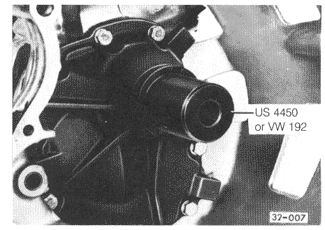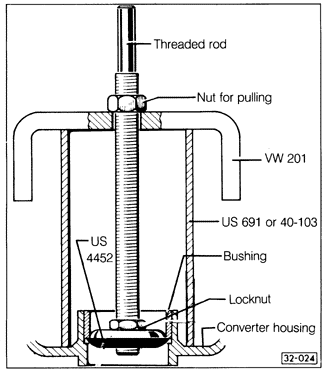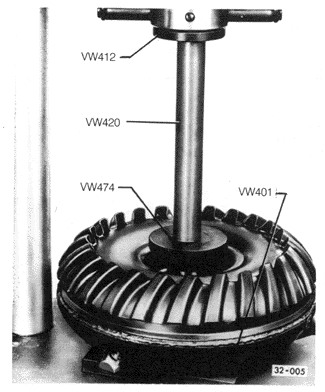Torque Converter Oil Seal
A leaking torque converter oil seal is often caused by a worn bushing in the torque converter hub. The bushing should always be checked if the seal is replaced. A worn bushing will promote rapid wear of the new seal.
To replace oil seal and check bushing:
| 1. | Pry the seal from the final drive housing using a chisel as shown in Fig. 5-6. |
| Fig. 5-6. | Faulty torque converter seal being removed with chisel. |

|
| 2. | Coat the new seal in ATF and drive the seal into place as far as it will go. See Fig. 5-7. |
CAUTION-
The seal is soft silicone rubber and easily damaged. Silicone seals must not contact gasoline or other solvents. Replace seals that are torn or have been exposed to solvents.
|
| Fig. 5-7. | Seal driver being used to install new torque converter seal onto one-way clutch support on final drive housing. Volkswagen special tool no. US 4450 or VW 192 shown. Use tool of approximate seal diameter to apply even installation pressure. |

|
| 3. | Check the torque converter oil seal hub for wear. See Fig. 5-8. Remove sharp edges and burrs with emery cloth. If the hub is deeply scored, the torque converter should be replaced. |
| Fig. 5-8. | Torque converter oil seal hub (arrow). |

|
| 4. | Measure the bore of the bushing inside the torque converter hub using an inside micrometer. If the diameter exceeds 34.25 mm (1.348 in.) or if the bore is out of round by more than 0.03 mm (.001 in.), the bushing should be replaced. |
| 5. | To replace the bushing, remove it using the Volkswagen special tools shown in Fig. 5-9. Press in the new bushing as shown in Fig. 5-10. |
| Fig. 5-9. | Torque converter bushing being removed. Numbers shown identify Volkswagen special tools. |

|
| Fig. 5-10. | Torque converter bushing being installed. Numbers shown identify Volkswagen special tools used with hydraulic press. |

|
NOTE-
Replacement bushings are manufactured to the correct size and do not require additional reaming or honing.
|
|




